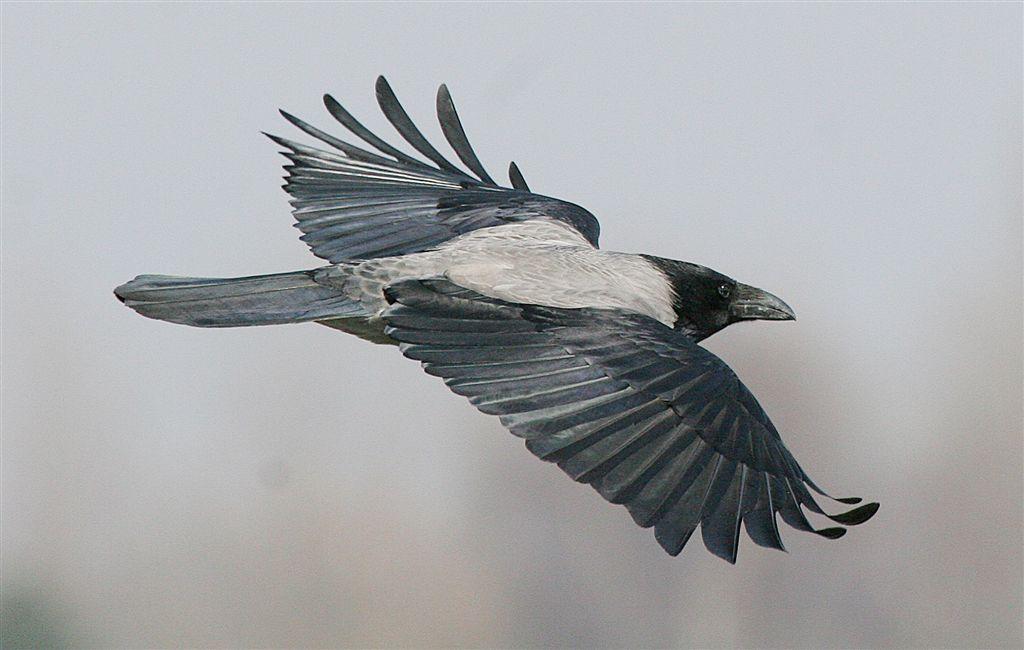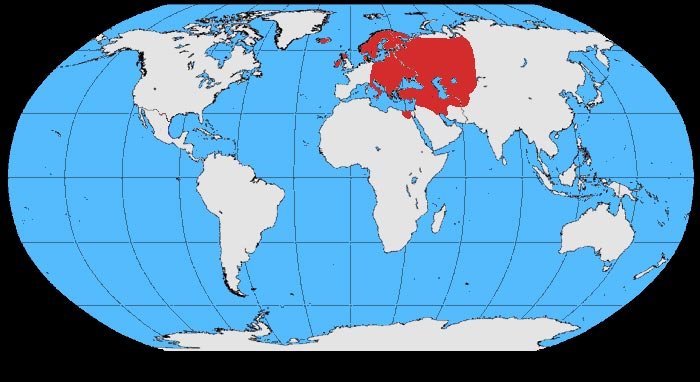Hooded Crow
Hooded Crow (Corvus corone cornix)
Photo: John Larsen
Hooded Crow
Corvus corone cornix, Gråkrage
The Hooded Crow (Corvus cornix) (sometimes called Hoodiecrow) is a Eurasian bird species in the crow genus. Widely distributed, it is also known locally as Scotch Crow, Danish Crow, and Corbie or Grey Crow in Ireland; Grey Crow is also what its Welsh name, Brân Lwyd, translates as. Found across Northern, Eastern and Southeastern Europe, as well as parts of the Middle East, it is an ashy grey bird with black head, throat, wings, tail and thigh feathers, as well as a black bill, eyes and feet. Like other corvids it is an omnivorous and opportunistic forager and feeder.
It is so similar in morphology and habits to the Carrion Crow (Corvus corone) that for many years they were considered by most authorities to be merely geographical races of one species. The fact that hybridization was observed where their ranges overlapped added weight to this view. However, since 2002, the Hooded Crow has been elevated to full species status after closer observation; the hybridisation was less than expected and hybrids had decreased vigour. Within the Hooded Crow species, four subspecies are recognized, with one, the Mesopotamian Crow, possibly distinct enough to warrant species status itself.
Taxonomy
The Hooded Crow was one of the many species originally described by Linnaeus in his 18th-century work Systema Naturae and it once again bears its original name of Corvus cornix. The binomial name is derived from the Latin words Corvus, "Raven", and cornix, "crow". It was subsequently considered a subspecies of the Carrion Crow for many years, and hence known as Corvus corone cornix, due to similarities in structure and habits. Since 2002, it has been re-elevated to full species status.
It is locally known as a Hoodie in Northern Ireland.
Subspecies
Four subspecies of the Hooded Crow are now recognised; previously all were considered subspecies of Corvus corone. A fifth, Corvus cornix sardonius (Trischitta, 1939) has been listed though it has been alternately partitioned between C. c. sharpii (most populations), C. c. cornix (Corsican population) and the Middle Eastern C. c. pallescens.
• C. c. cornix, the nominate race, occurs in the British Isles (principally Scotland and Ireland) and Europe, south to Corsica.
• C. c. pallescens (Madarász, 1904) is found in Turkey and Egypt, and is a paler form as its name suggests.
• C. c. sharpii (Oates, 1889) is named for English zoologist Richard Bowdler Sharpe. This is a paler grey form found from western Siberia through to the Caucasus region and Iran.
• C. c. capellanus (P.L. Sclater, 1877) is known as the Mesopotamian Crow or Iraqi Pied Crow. This distinctive form occurs in Iraq and southwestern Iran. It has very pale grey plumage which looks almost white from a distance. It is possibly distinct enough to be considered a separate species.
Description
Except for the head, throat, wings, tail and thigh feathers, which are black and mostly glossy, the plumage is ash-grey, the dark shafts giving it a streaky appearance. The bill and legs are black; the iris dark brown. There is only one moult, in autumn, as in other crow species. The male is the larger bird, otherwise the sexes are alike. The flight is slow and heavy and usually straight. The length varies from 48 to 52 cm (19 to 20 in). When first hatched the young are much blacker than the parents. Juveniles have duller plumage with bluish or greyish eyes and initially a red mouth. Wingspan is 98 cm (39 in) and weight is on average 510 grammes.
The Hooded Crow, with its contrasted greys and blacks, cannot be confused with either the Carrion Crow or Rook, but the kraa call notes of the two are almost indistinguishable.
Distribution and habitat
The Hooded Crow breeds in northern and eastern Europe, and closely allied forms inhabit southern Europe and western Asia. Where its range overlaps with Carrion Crow, as in northern Britain, Germany, Denmark, northern Italy and Siberia, their hybrids are fertile. However, the hybrids are less well-adapted than pure-bred birds, and this is one of the reasons that this species was split from the Carrion Crow. There are some areas, such as Iran and central Russia, where little or no interbreeding occurs.
In the British Isles, the Hooded Crow breeds regularly in Scotland, the Isle of Man, and in the Scottish Islands. It also breeds widely in Ireland. In autumn some migratory birds arrive on the east coast of Britain. In the past, this was a more common visitor, and in Hertfordshire was known as the Royston Crow after the town of Royston. The 150-year old local newspaper is still titled Royston Crow, and depicts the bird's head on its masthead.
Diet
The Hooded Crow is omnivorous, with a diet similar to that of the Carrion Crow, and is a constant scavenger. It drops molluscs and crabs to break them after the manner of the Carrion Crow, and an old Scottish name for empty sea urchin shells was "crow's cups". On coastal cliffs the eggs of gulls, cormorants and other birds are stolen when their owners are absent, and it will enter the burrow of the Puffin to steal eggs. It will also feed on small mammals, scraps, smaller birds and carrion.
Nesting
Nesting occurs later in colder regions: mid-May to mid-June in northwest Russia, Shetland and the Faroe Islands, and late February in the Persian Gulf region. In warmer parts of the British Isles, the clutch is laid in April. The bulky stick nest is normally placed in a tall tree, but cliff ledges, old buildings and pylons may be used. Nests are occasionally placed on or near the ground. The nest resembles that of the Carrion Crow, but on the coast seaweed is often interwoven in the structure, and animal bones and wire are also frequently incorporated. The four to six brown-speckled blue eggs are 4.3 x 3.0 centimetres (1.7 x 1.2 in) in size and weigh 19.8 grammes (0.71 oz), of which 6% is shell. The altricial young are incubated for 17-19 days by the female alone, who is fed by the male. They fledge after 32 to 36 days. Incubating females have been reported to obtain most of their own food and later that for their young.
The typical lifespan is unknown, but that of the Carrion Crow is four years. The maximum recorded age for a Hooded Crow is 16 years, and 9 months old.
This species is a secondary host of the parasitic Great Spotted Cuckoo, the European Magpie being the preferred host. However, in areas where the latter species is absent, such as Israel and Egypt, the Hooded Crow becomes the normal corvid host.
This species, like its relative, is seen regularly killed by farmers and on grouse estates. In County Cork, Ireland the county's gun clubs shot over 23,000 Hooded Crows in two years in the early 1980s.
Status
The IUCN Red List does not distinguish the Hooded Crow from the Carrion Crow, but the two species together have an extensive range, estimated at 10 million square kilometres (3.8 million square miles), and a large population, including an estimated 14 to 34 million individuals in Europe alone. They are not believed to approach the thresholds for the population decline criterion of the IUCN Red List (i.e., declining more than 30% in ten years or three generations), and are therefore evaluated as Least Concern. The Carrion Crow/Hooded Crow hybrid zone is slowly spreading northwest, but the Hooded Crow has of the order of three million territories in just Europe (excluding Russia).
Cultural Significance
In Celtic folklore, the bird appears on the shoulder of the dying Cú Chulainn, and could also be a manifestation of the Morrígan, the wife of Tethra, or the Cailleach. This idea has persisted, and the Hooded Crow is associated with fairies in the Scottish highlands and Ireland; in the 18th century, Scottish shepherds would make offerings to them to keep them from attacking sheep. In Faroese folklore, a maiden would go out on Candlemas morn and throw a stone, then a bone, then a clump of turf at a Hooded Crow - if it flew over the sea, her husband would be a foreigner; if it landed on a farm or house, she would marry a man from there; but if it stayed put, she would remain unmarried.
The Hooded Crow is featured on the crest of the North Hertfordshire District Council. It is also one of the 37 Norwegian birds depicted in the Bird Room of the Royal Palace in Oslo. Jethro Tull mentions the Hooded Crow on the song "Jack Frost and the Hooded Crow" as a bonus track on the digitally remastered version of Broadsword and the Beast and on their The Christmas Album.
ref.:
Hooded Crow (Wikipedia)
Hooded Crow (Google)
Hooded Crow (Google Pics)
Corvis cornix (YouTube)
The voice (Corvus cornix)
+++++++++++++++++++++++++++++++++++
Have you got any comment, please mail:
Sincerely
Kurt Starlit
aka CykelKurt
Crows of The World


